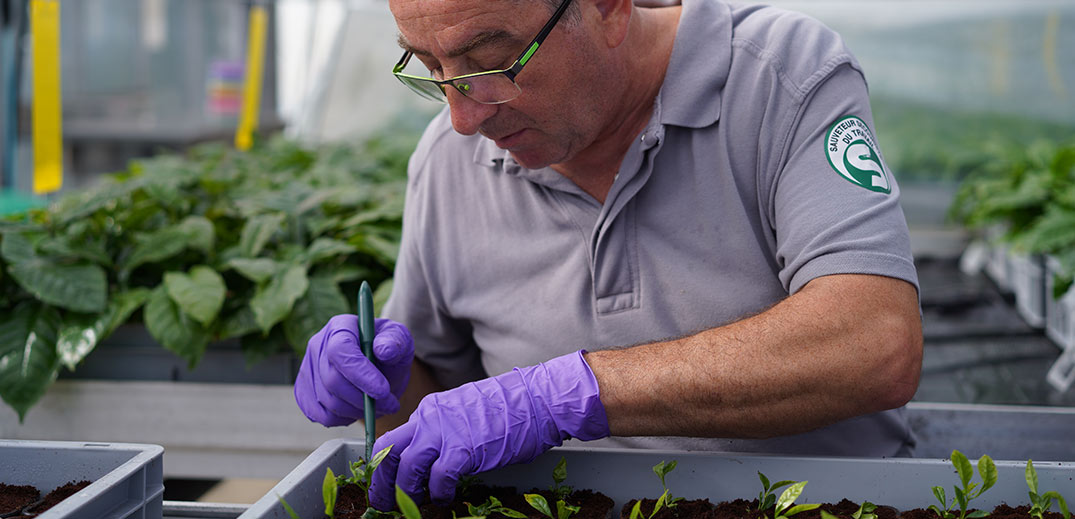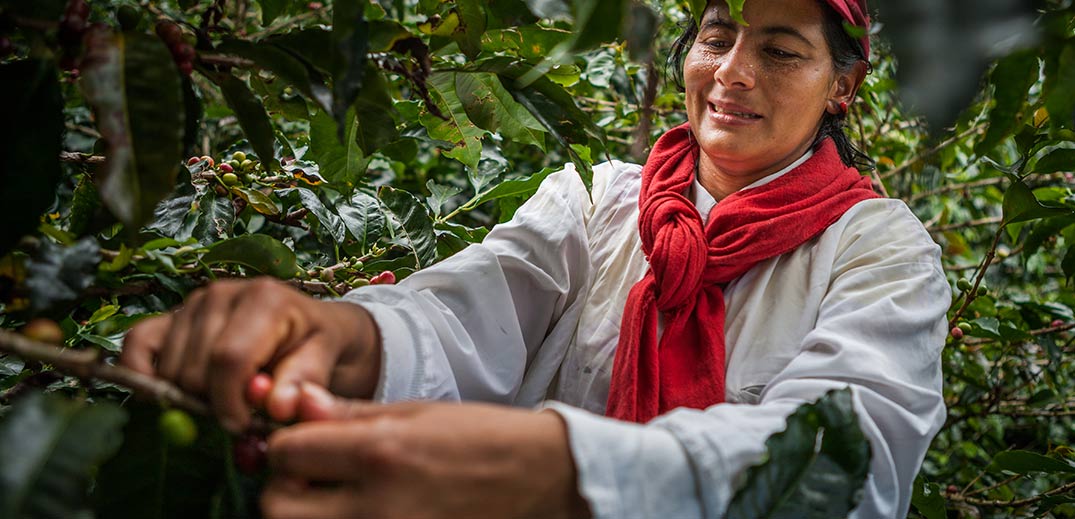As one of the more than 1 billion people worldwide who drink coffee daily, did you know that climate change is reducing the amount of arable land that it's possible to grow coffee on, while water shortages are reducing yields significantly?
With global coffee demand rising fast, we need to ensure that great tasting, sustainably grown coffee is available for generations to come.
As with any food product, the objective is to minimize coffee's carbon footprint. In this context it is important to note that green coffee beans are responsible for a significant percentage of greenhouse gas emissions associated with every cup of coffee. So the question is, how can we grow more high quality coffee sustainably to meet rising global demand, while significantly reducing coffee's carbon footprint, to support Nestlé's commitment to net zero emissions by 2050?
To address this challenge, Nestlé's plant scientists have made a major breakthrough by developing low carbon coffee – two new Robusta varieties with up to 50% higher yields per tree versus standard varieties. Because farmers can now grow more coffee using the same amount of land, fertilizer and energy, the result is an up to 30% reduction in the carbon footprint of green coffee beans. Since the green beans account for 40-80% of CO2 equivalent (CO2e) emissions per cup of coffee, the impact is massive. Let's take a closer look at how we developed these new varieties.
Deep plant science expertise and large 'library' of coffee varieties
To do so, we need to step inside Nestlé Research in Tours, France, the Nestlé R&D center responsible for all our plant science activities. Here, and on the company's experimental coffee farms, you'll find our comprehensive library of coffee varieties. With climate change threatening many varieties, this collection helps to safeguard the coffee plant's full biodiversity.
This biodiversity also allows us to identify traits such as higher bean yields and better drought and disease resistance, which are found individually across different trees, and then to breed new, improved coffee varieties that combine these benefits. To reach this stage we apply advanced sequencing techniques to characterize the genetic makeup of the trees, while also recording their 'phenotypical' or observable traits.
World-class knowledge of traditional coffee breeding
Having screened and identified promising 'parent' coffee trees, we apply our world-class knowledge of traditional, non-GMO plant breeding and propagation to grow several hundred offspring or 'plantlets' of a given new variety for testing on the experimental farms.
Through these farms, and Nestlé's wider agronomic network, our teams have the unrivalled ability to test new coffee varieties across the Americas, Asia and Africa – to compare the plants' traits and performance under different soil and climatic conditions.
Once we’ve identified the best-performing varieties, we work with official coffee research institutes worldwide, cooperatives and local farmers to test the new varieties further under real life conditions. If farmers favor the new plants, they are registered with the local authorities in question, and propagated for distribution to farmers, including those registered in the Nescafé Plan.
Regenerative farming practices and local agronomist support
Nestlé agronomists then support farmers to ensure that the coffee is grown as sustainably as possible. Our teams guide farmers concerning the best tree architecture, assessment of soil quality, disease diagnosis, pest control measures and appropriate use of fertilizers. They show them how to use less water and energy while encouraging regenerative agricultural practices such as multi-cropping.
How is our low carbon coffee performing in the field? Well, following a thorough selection process by our scientists, farmers in Latin America are now growing one of the new varieties that delivers up to 50% higher yields and an up to 30% lower carbon footprint on the farm, for use in Nescafé. This significant reduction is mainly related to the reduced usage of fertilizers per ton of green beans and the lower energy consumption in the field and during green bean drying. In addition, less land is required to produce the same amount of green coffee.
Trialing next generation coffee varieties
Fabrizio Arigoni, Head of Plant Science at Nestlé, is proud of what his skilled team has achieved to date, including the development of the new low carbon coffee varieties. Nonetheless, he is keen to emphasize that this is only the start, in terms of the new varieties that Nestlé is developing, using only traditional, non-GMO methods.
"Reducing the carbon footprint of green coffee is vital – for the sake of our planet and to help Nestlé achieve net zero emissions by 2050 – so developing new higher yielding varieties with an even lower carbon footprint, plus disease- and drought-resistance, remains our top priority," Fabrizio says.
"That said, millions of improved coffee plantlets have already been distributed to farmers globally through our Nescafé Plan. These new varieties have enabled them to significantly increase their yields, and improve their incomes, sustainably."
Reducing the carbon footprint of green coffee is vital – for the sake of our planet and to help Nestlé achieve net zero emissions by 2050Fabrizio Arigoni Head of Plant Science at Nestlé
With trials already underway to select the next generation of elite Arabica and Robusta coffee varieties for specific regions, Fabrizio's team will soon be able to unveil new breakthrough varieties. For example, during the last decade, 'coffee leaf rust' has devastated coffee plantations across Latin America, and Nestlé is developing new higher-yielding Arabica varieties with increased resistance to the disease, since this coffee species is more vulnerable to it.
The next generation of low carbon and drought-resistant varieties is also in the pipeline. "We're preparing to plant a newer Robusta elite variety with 100% higher yields versus other varieties, while we're trialing a drought-resistant coffee in Central Africa that delivers up to 50% higher yields per plant during times of moderate to severe water stress. In terms of new Nestlé coffee varieties, the best is yet to come!" Fabrizio says.
Across every stage in the value chain, from breeding and growing coffee sustainably in the fields, roasting green beans to perfection and then grinding and brewing them to create the most delicious and aromatic cup, Nestlé low carbon coffee revolution is brewing. With its longstanding expertise in coffee plant science, Fabrizio's team is helping to 'plant the seeds'.









